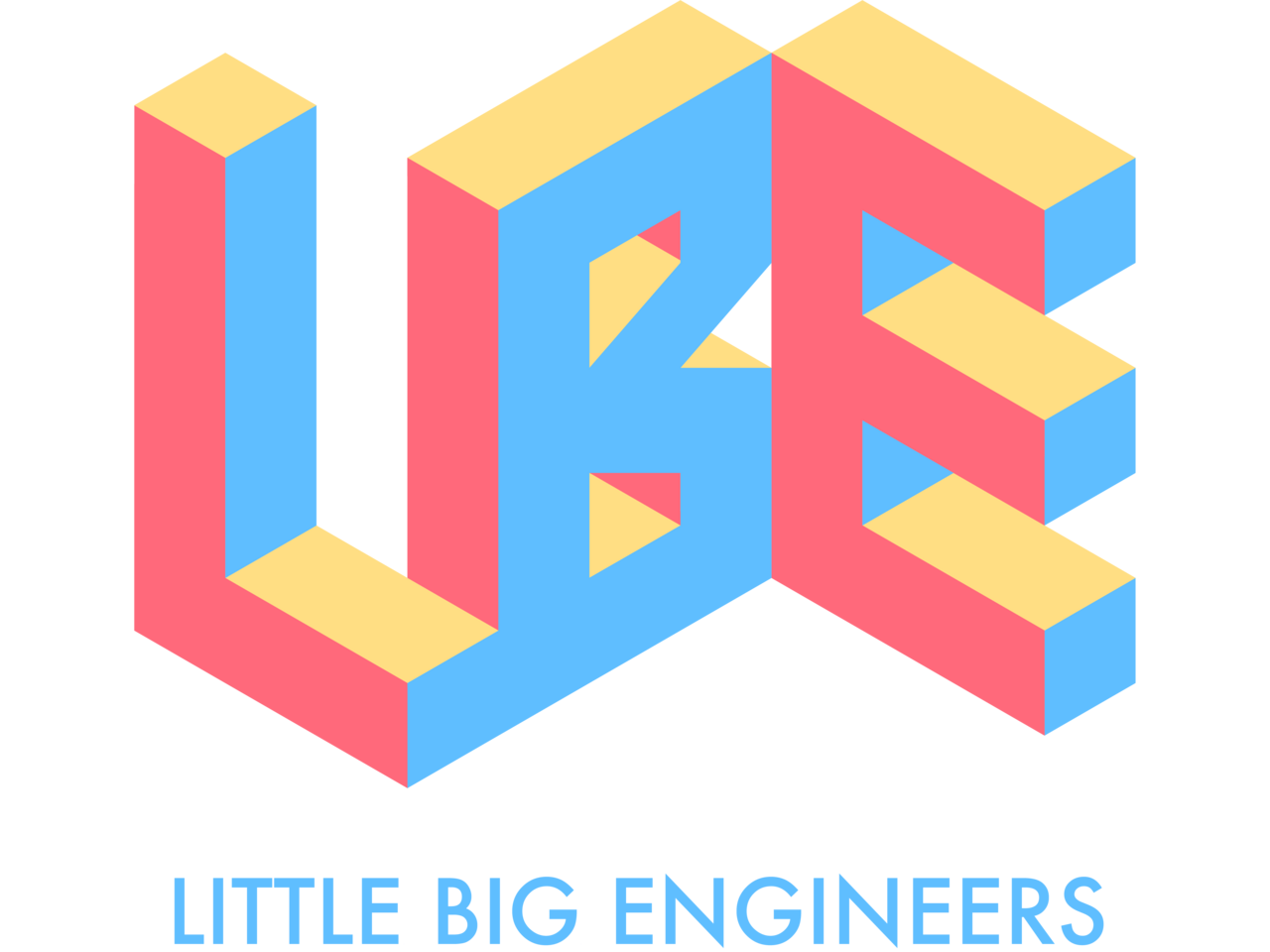This week we conducted a paper playtest, received a variety of feedback, and made huge progress in several different domains of the project. We struggled to integrate all of the pieces of progress together into one cohesive whole, but by the end of the week, we felt much more confident for week 6.
Paper Playtest
We conducted a paper playtest at Hunt Library with the help of this semester’s playtest TA, Weilin. Kat and Ivy were able to test with four groups of three people each, all CMU students. Our playtests ran like a tabletop storytelling game, with some interactions between our testers and paper props. We tested the interaction flow from last week’s design.

While much of the feedback seemed positive, statements like “I would definitely do this again” can be deceptive. Upon closer examination of player behavior, this kind of statement came from players who got the “evil” ending and did not understand that a different path was possible until the end. This statement actually indicates that while the world was appealing, the players were confused and hoped that more time in the world would fix their confusion. It raised serious doubts about how coherent the “evil” ending actually is, which is especially concerning because ¾ groups got that ending.
The “evil” ending actually seemed much more intuitive, because immediately preceding the choice to use the wand to slay the dragon, the guests are using the wand for a magic spell. This was great to learn at this relatively early stage. We certainly don’t want our guests to end up doing something for no conscious reason, especially if that leads them on a narratively unsatisfying path.
One guest asked if she could steal the eggs! This question stunned us for a bit, because we had not thought about what would happen if a guest tried to steal our physical eggs, but realized that they absolutely might want to. This piece of feedback also reveals an important guest motivation- the motivation to care for an egg that they had very quickly grown attached to. Going forward, we need to keep this motivation in mind and make it clear to the guests that returning the eggs to their mother dragon is the way to protect them.
Production
This week, two areas of production became crucial: budget and documentation. As we get one week closer to Halves in Week 7, we need to start making large purchases ASAP. This involves a lot of logistical work, especially considering that immediately following Halves week is Fall Break. We put together budgets for both technology and set design, with the goal to get them approved and start making large purchases ASAP.
In the process of budgeting, we also created a Content Map. This will help us communicate exactly what technology we are borrowing and purchasing, and how everything fits together to form each part of the experience.
This week was a challenge from a production standpoint, because there was no day this week that both producers were in the building together. Illness is an unfortunate reality of production, but luckily neither of us came down with anything severe.
Set Design
This week, we made two revisions to our room layout: the first because we had forgotten to accommodate the fact that our project room door does not open a full 180 degrees, and the second in tandem with a story revision. With these revisions, we now have exact dimensions for the different types of “walls” in our experience and the floor covering the ETC requires. We also brainstormed ways to theme our office furniture, rather than attempt to store it in the extremely overfull ETC storage spaces.
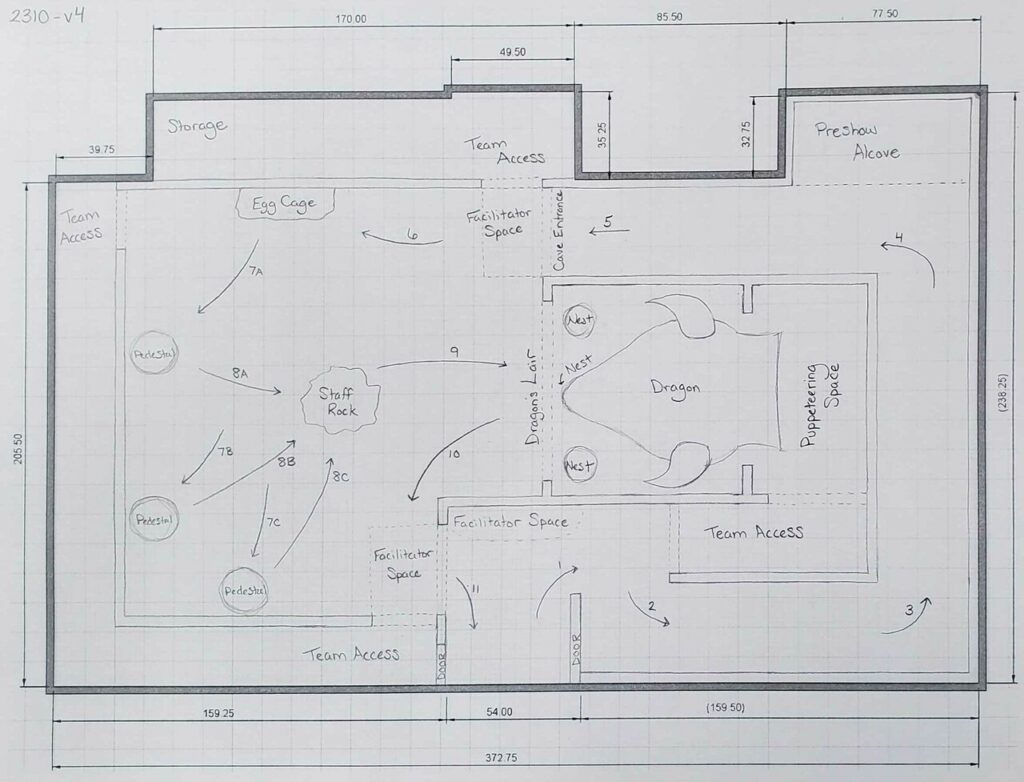
The set-relevant story revision was to place our experience in a dragon temple, rather than a dragon cave. This revision makes the Elemental Guild’s relationship with the dragon eggs much more coherent, but it also provides a few advantages to our immersion. We no longer have to be concerned that the presence of right angles breaks immersion, and the pedestals that hold our eggs won’t require spending inordinate amounts of time making them look like stalagmites. There are now good reasons for RFID tap point symbols to be carved into surfaces. It was a great change and we are very happy to move forward with this in mind.
Finally, we blocked out our dragon head puppet in cardboard! This was based on concept art done by our artist Ivy. However, this version’s horns are placed incorrectly on the head, because we want them to ultimately be placed on a part of the head that doesn’t exist in just these few planes. She’s very large, and may require two puppeteers. However, we are going to try everything possible materials-wise to make her light enough for one puppeteer.
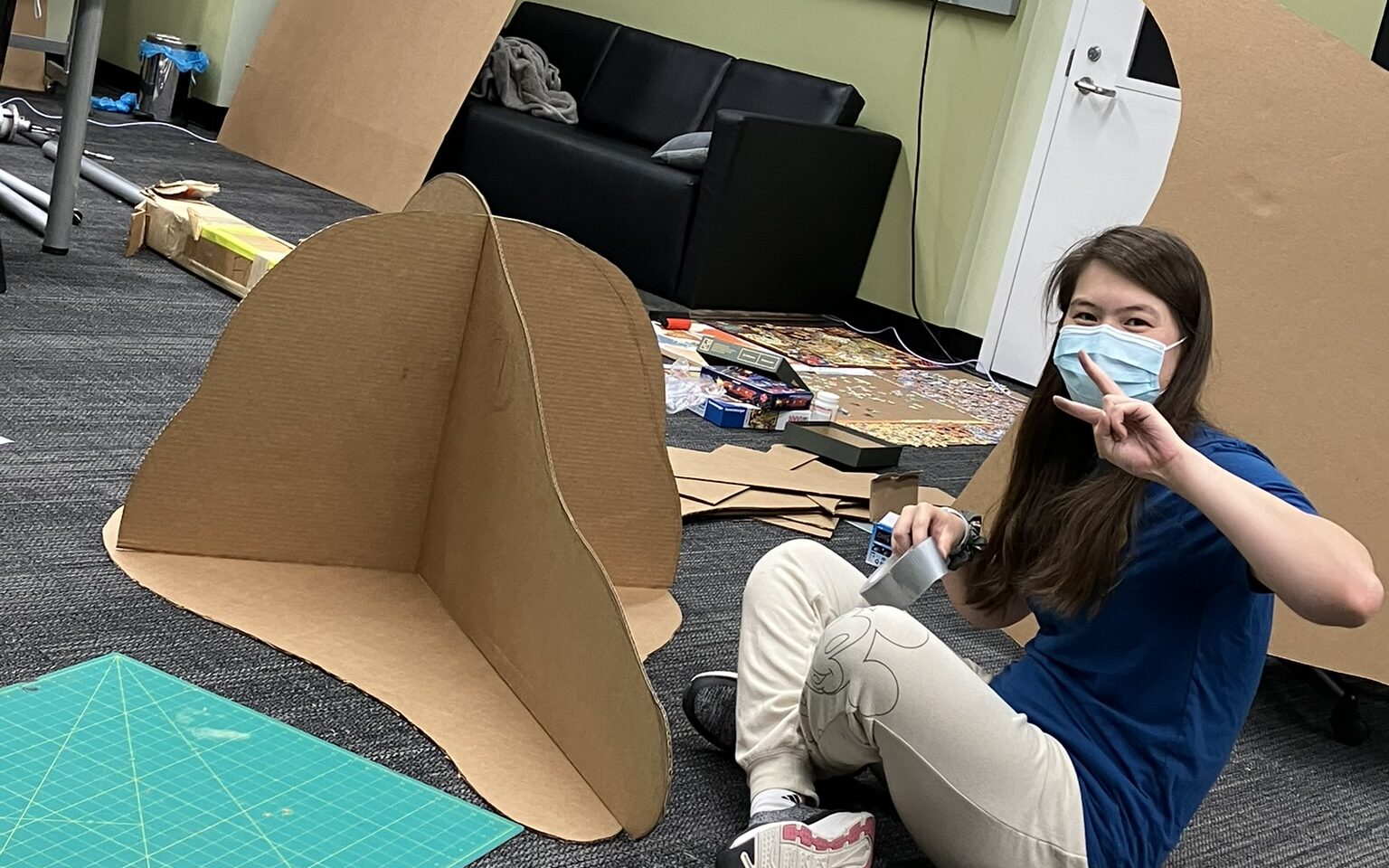
We got a lot of potential supplies for the project from Janice Metz and Dave Purta. These include pipe and drape, a fog machine, many different LED lights, EL wire, and the ETC’s Phidgets. Taking stock of all these items made clear what kinds of things we will need to source from elsewhere. For instance, the ETC owns a huge amount of drape, but just 14 horizontal feet of pipe! Who knew!
Technology
This week, Cleo finished the prototype for our post-show interactions. These are Raspberry Pis with an MFRC522 RFID antenna module and a pico projector. When you tap the RFID tag, a video will play on the projector.
We tested different ways to play video on Raspberry Pi. Originally, we considered using Unity, but there was significant lag in the video playback. Therefore, we settled on using OpenCV instead.
We decided to have two sets of RFID dragon scales: the experience scales, designed to work with Phidget RFID antennas connected to a PC, and giveaway scales, designed to work with our Raspberry Pi setup. This way is more budget-friendly and makes much more sense with the programming work.
Additionally, we have found places in the story where an actual RFID antenna is not needed, but rather a simple weight sensor Phidget. This works well for the interaction of picking up the dragon eggs and placing them in the nest.
Our wand technology is up and running, with some very interesting issues. Because we are not using the block coding companion app made by Kano, the wand disconnects from Bluetooth after three minutes. Wand tech issues may not be a huge problem, however, because we are realizing that the wand’s connection to our story is getting more and more tenuous, and it may be eliminated.
Story
We’ve been struggling this week with synthesizing conflicting feedback. When we playtested with other students, it at first seemed to reinforce our thought that a branching story with two endings would create the most player interest. We thought the feedback that playtesters wanted to play again was great for a story with two endings! However, as we mentioned above, we realized we were getting this feedback for two reasons: the evil ending was weak, and players liked the DND-esque writing style of the environment descriptions, which won’t be present in the final product. They didn’t want to play again because the narrative was actually good, rather, they wanted more information to be told to them so they’d be less confused.
Because of the scope required to do a good job making two endings both unique and thematically coherent, we decided to move towards just one ending. We also discussed that the Bluetooth wands may not be actually needed for our experience, and in fact might be overly confusing without the dragon slaying ending.
We had a realization that high throughput does not require a short experience length! Rather, it just requires multiple groups of guests to be going through each area of the experience one after another. In simple terms, we don’t need to shorten the ride time of our metaphorical roller coaster. We just need to design it so it can have two or three or four coaster trains.
Going forward, we’ll need to fully script out all of the information we want to deliver to the guests, and have that locked down by the middle of next week. We want this script to keep the central theme of guests earning the dragon’s trust in mind, so that it makes sense throughout the entire story, not just at the end.
Prop Making
On Sunday, Christine Barnes arrived in Pittsburgh! She is in town to guest lecture for Shirley Saldamarco’s course, Guest Experience in Theme Park Design. However, she was able to come up several days before and spend a whole day sharing her wisdom from the theater and themed entertainment industries.

We spent the morning going through craft stores and dollar stores, brainstorming different materials for the various props we will need. We did not buy big-ticket set pieces yet, but with knowledge of these different materials and what it takes to use them, we are much more confident that we can design a fantastic set without breaking the bank.
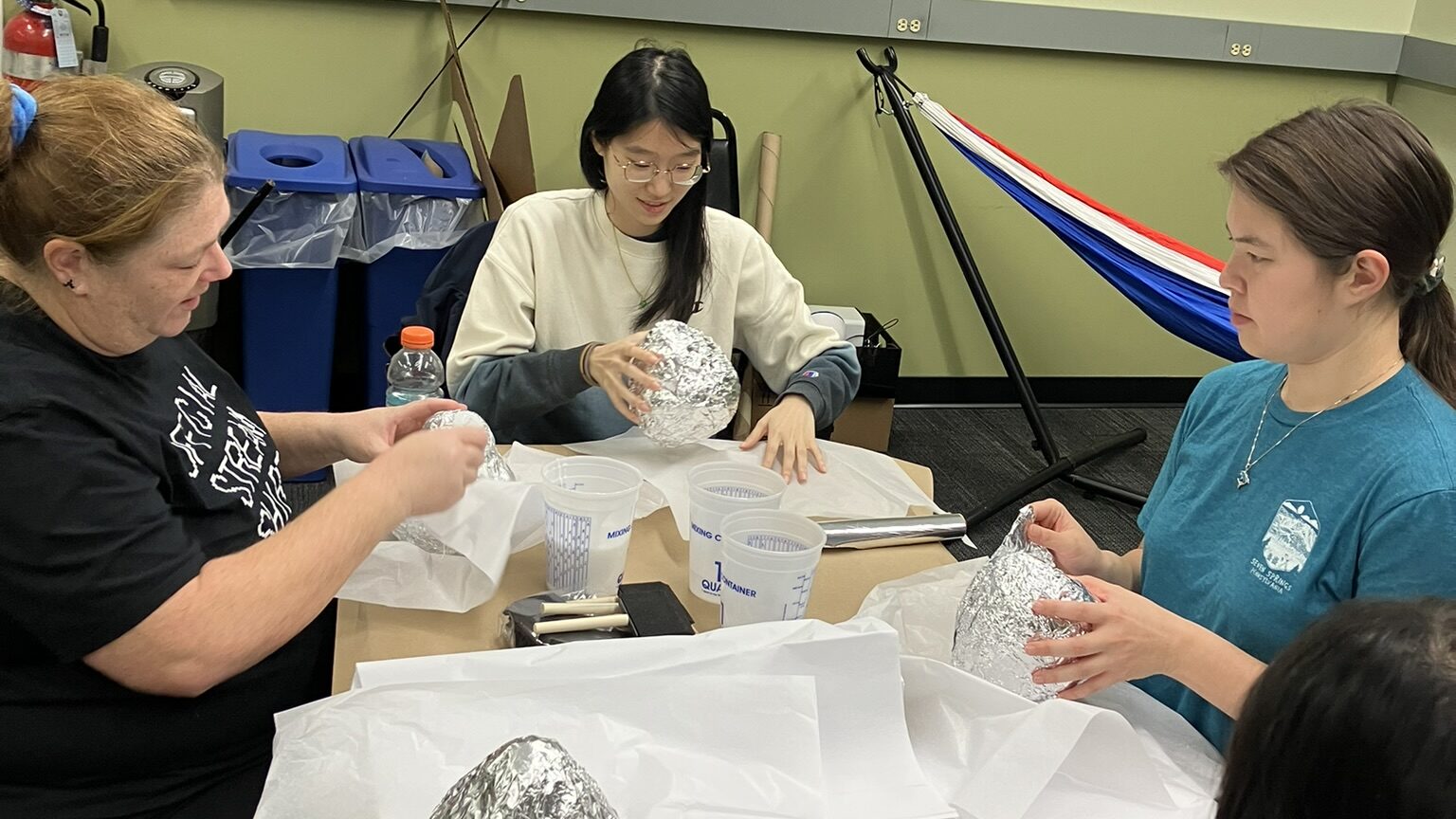
In the afternoon, Christine taught us a basic prop-making sculpture technique and we were able to craft nine dragon eggs for approximately $1 each! Over the next two days, Christine will visit other project rooms, be a naive guest for BVW, and work with us for several more hours. We’re looking forward to learning more about puppetry, carpentry, and environmental storytelling.
Jigsaw Puzzle
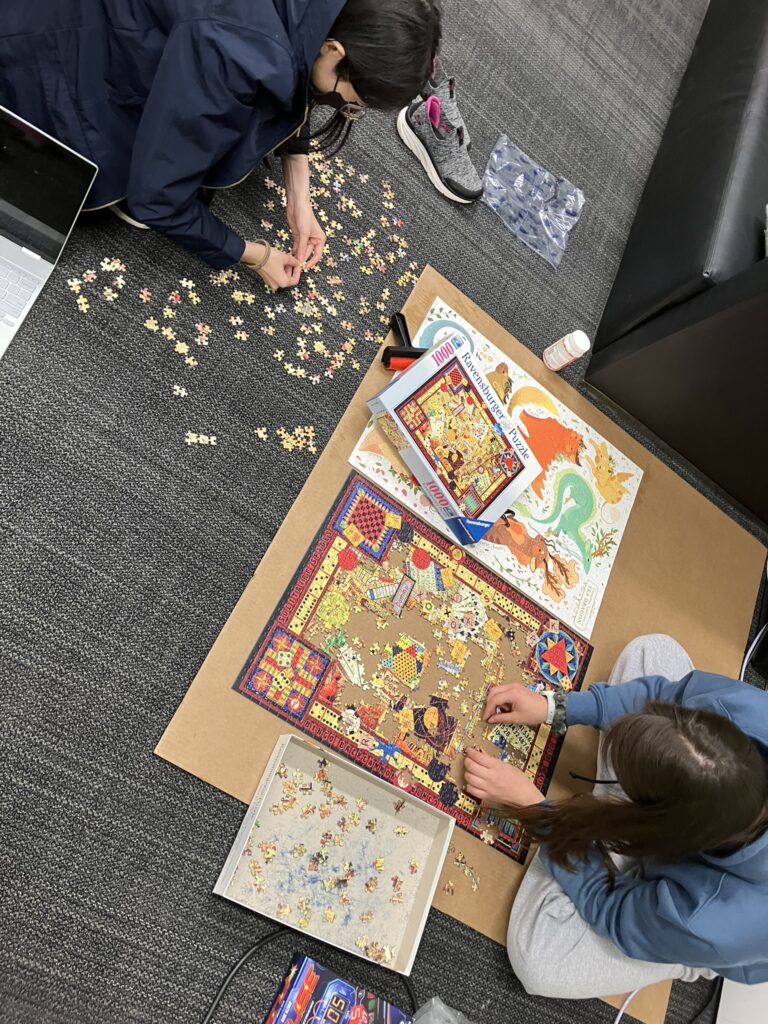
Just a quick jigsaw puzzle update for fun, we finished the Vintage Games jigsaw puzzle (from Ravensburger) and are moving on to the Taco Tuesday puzzle (from Puzz)! We do jigsaw puzzles together when we need to take a brain break, and it’s nice to work together on something and feel accomplished.
Goals for Next Week
We only have one week before Halves, so a few things absolutely must get done before then.
- A final story, locked down by Wednesday
- A puppet armature design
- An RFID + DMX lighting prototype
- A presentation, able to be rehearsed by Thursday
- Concept art or storyboards for the environments and flow.
TL;DR
This week, we found through playtesting and experimentation that many different pieces of our experience– the story’s ending, the room layout, and the user experience attached to the wand– weren’t working as well as we had predicted. While this was initially discouraging, we were able to synthesize the feedback to make some big, hard decisions. We are behind in fabrication at this point, but our design is much stronger than it was at the start of the week. Preparing for Halves in Week 7 will force us to make everything even more cohesive and easily communicated, and we aim to fabricate as much as possible to demo during our presentation.
